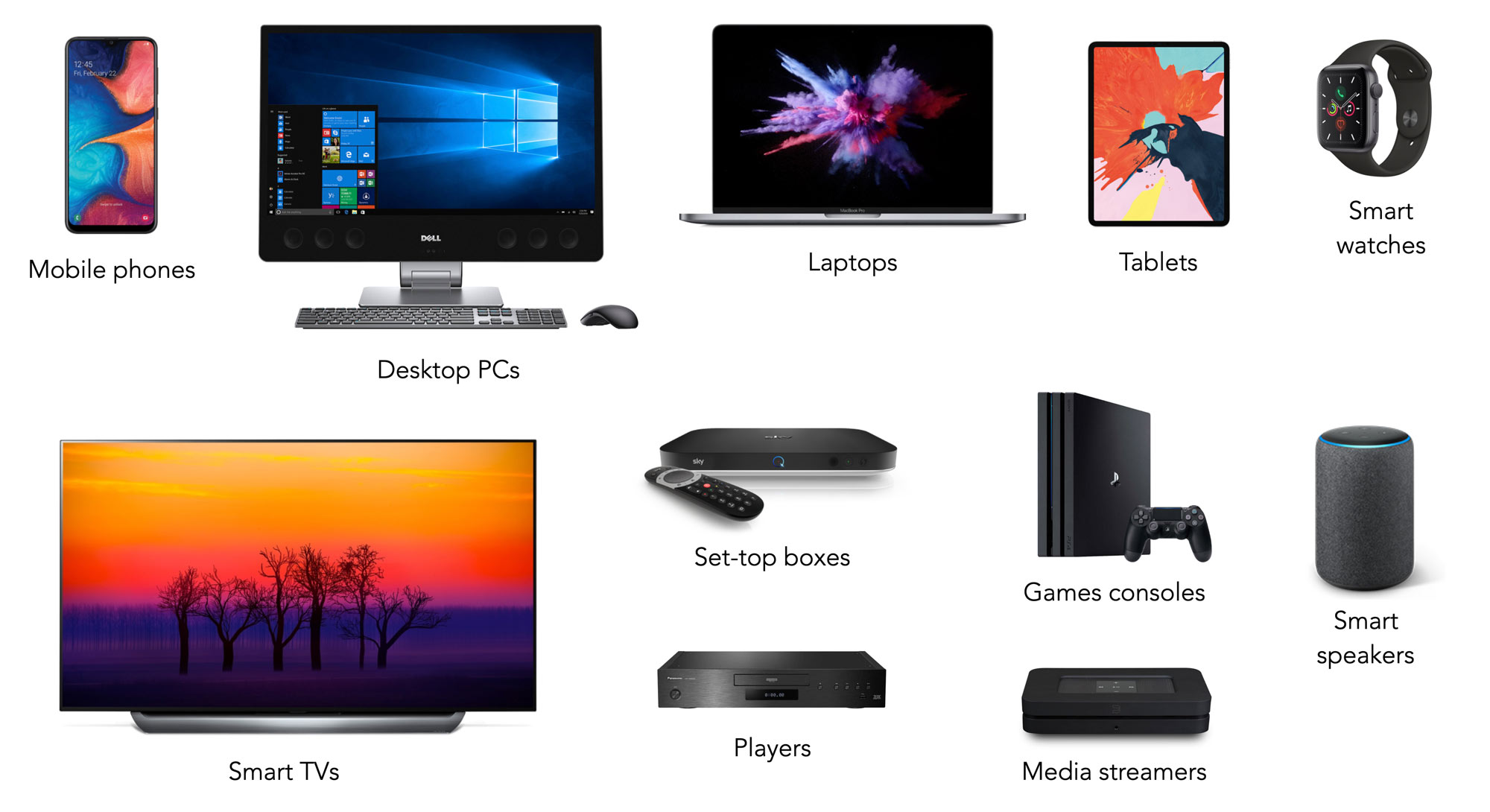On this page, we give ten reasons why superfast broadband is becoming increasingly essential for consumers and businesses. Superfast broadband, offering download speeds of at least 30 Mbps, is now available to 95% of UK premises.
1. Superfast broadband is needed to support an increasing number of devices in the home
You may be surprised when you count up the number of devices you have that connect to the Internet, and the number is probably only going to increase!

Basic standard broadband struggles to support the increasing number of Internet-capable devices in the typical home, which can include:
- mobile phones/smartphones (probably used by every member of a household)
- desktop PCs
- laptops
- tablets and iPads
- smart watches
- smart TVs (e.g. accessing Netflix, Disney Plus, Amazon Prime or BBC iPlayer)
- set-top boxes (e.g. Apple TV, Sky Q and the Virgin TV Box)
- players (e.g. DVD, blu ray and Ultra HD blu ray players)
- games consoles (e.g. Sony PS4)
- media streamers (e.g. Roku Streaming Stick+ and Bluesound NODE 2i)
- smart speakers (e.g. Sonos One and Amazon Echo).
Ofcom has identified strong growth in the adoption of Internet-enabled devices, with each household in the UK now having several different types of Internet-enabled device. As outlined in our Broadband Statistics page, 63% of households have a laptop and 54% have a tablet device. Most new television sets sold in the UK are ‘smart TVs’ and more than half (53%) of households have, in some way, an Internet connection to their TV. Eight in ten adults (79%) now have an Internet-enabled smartphone.
All these devices will be competing for the same limited bandwidth (when they access the Internet or perform a software update), and basic broadband services with slow speeds will increasingly become a major bottleneck.
The situation is even worse when there are several people living in the household when standard broadband is woefully insufficient. All too often parents may be struggling to access the Internet while their children are trying to watch YouTube in their rooms.
2. Without superfast broadband, consumers miss out on bandwidth-intensive services such as TV and video

In many ways, TV and video services have become the ‘killer application’ of superfast broadband. Without superfast broadband, the choice of TV and video is becoming increasingly restricted. Without superfast broadband, picture quality can be degraded with playback often interrupted by buffering.
Traditional and pay-TV broadcasters are increasingly using broadband to deliver services. As described in our blog article about BBC iPlayer, the BBC has recently announced that its iPlayer service will be the gateway to all BBC programmes, marking a considerable change in emphasis. Pay-TV services (such as Sky) are increasingly using broadband to download or stream ‘on demand’ content. For example, when Sky Q viewers tune in to a conventional movie channel mid-way through the movie, the viewer is given a choice to watch the movie from the beginning (which is then downloaded via the broadband connection). The slower the broadband connection, the longer the viewer has to wait to view the content.

More than half of all UK households now subscribe to at least one subscription video-on-demand service, and services such as Netflix, Amazon Prime Video and NOW TV have been joined by Apple TV Plus, BritBox and Disney Plus. Don’t forget to view our Apple TV Plus review and Disney Plus review.
On top of the increasing number of subscription video-on-demand services, YouTube has seen a substantial increase in adoption over time. YouTube can consume consideration bandwidth, particularly if viewed on several devices in a household. According to Ofcom, YouTube is a major part of total video viewing and total online time. 12% of all time spent watching video, and 13% of all time spent online by adults, is spent on YouTube. Young adults (16-34s) spend over an hour on YouTube per day, and almost all adult internet users watch YouTube videos. UK adults watch, on average, about half an hour of YouTube per day.
With all online video services, there is a noticeable quality trade-off for streamed services as the bandwidth available is reduced in terms of picture and sound quality. With most providers moving rapidly towards improving picture and sound quality, with Ultra HD 4k video and enhanced Dolby Atmos sound, superfast broadband is essential to now watch programmes at their best. As discussed in our iPlayer article, the BBC is ramping up its Ultra HD programming on iPlayer, and the BBC has recommended a minimum speed of 40 Mbps to view its live Ultra HD content (such as Wimbledon). As outlined in our Apple TV Plus review, Apple’s streamed TV service uses a video bit rate of about 25 Mbps for its Ultra HD 4k content, and Netflix recommends an Internet connection with at least 25 Mbps download speed to stream titles in their best (Ultra HD 4k) resolution.
Given that other online services may well be used at the same time as streamed TV and video sessions in a household, and simultaneous TV streaming sessions could easily take place, the minimum download speed of 30 Mbps to be formally defined as ‘superfast broadband’ is not looking as plentiful as it was several years ago. Broadband will quickly become the mainstream mechanism for delivering TV and video services to many households, and superfast broadband (30 Mbps+) and, increasingly, ultrafast broadband (100 Mbps+) will be absolutely essential.
3. Superfast broadband provides substantially improved performance for delay-sensitive services, such as online gaming and voice and video telephony

While it is easy to get our heads around how superfast broadband better supports services that require a lot of bandwidth, such as TV and video streaming (discussed above), less well known and talked about is how superfast broadband brings significant performance improvements to services that are very sensitive to time delay, such as:
- online gaming
- video and voice telephony/conferencing (including Skype and Zoom).
Conventional broadband uses copper telephone cables all the way from the exchange to a house or business and this is often a considerable distance (several kilometres). The technology used to reliably send the broadband data can inevitably add significant time delay (latency) and delay variability (jitter). As described in our article What is Fibre Broadband, superfast broadband is generally delivered using a technology called Fibre to the Cabinet (FTTC) – where telephone cables are replaced by speedy and reliable fibre-optic cables for a substantial proportion of the journey between the exchange and customers, which can substantially reduce overall latency and jitter.
Online gamers are often justifiably obsessed about minimising their ‘ping’ – which is the average total time it takes for a gaming device to send data to the online gaming server and back – as low ping values give smoother gameplay and a lag-free user experience. Superfast broadband can often improve ping by 10ms or more over conventional broadband.
Similarly, latency and jitter can wreak havoc with video and voice telephony services, such as Skype and Zoom, which can suffer from annoying glitches, drop-outs and delays. The global coronavirus pandemic has fuelled the mass adoption of services such as Skype and Zoom, for both business and personal use and its long-lasting legacy will probably be one of introducing such services to a much broader audience. With its reduced latency and jitter compared with conventional broadband, superfast broadband generally provides a much more reliable, and less frustrating, experience with these services. Furthermore, by allowing higher data rates to be used, sound and video quality will be maximised.
Another advantage of superfast broadband over conventional broadband is that the higher connection speeds offered allow quality of service methods to be more easily implemented to improve the performance of time-sensitive services even further. Video streaming (for example, from Netflix or YouTube) or file downloads/uploads can often wreak havoc with delay sensitive applications because of how the Internet and routers typically work. With superfast broadband, users have the opportunity to trade some of the higher speeds available compared with standard broadband to implement quality of service mechanisms (known as Smart Queue Management) to dramatically improve the performance of time-sensitive services. For more information, please view our article Bufferbloat: why it is harming your broadband and how to easily fix it.
4. Superfast broadband delivers a more responsive experience for many applications

While it is easier to explain how superfast broadband makes a big difference to certain applications, for example, by allowing applications such as Ultra HD 4k video streaming to actually work or significantly improving time-sensitive applications, the reality is that the superior data rates and reduced latency and jitter of superfast broadband bring substantial benefits to a host of popular online services, including:
- browsing
- online shopping
- online banking
- social media (e.g. Facebook).
People who have migrated from conventional to superfast broadband often comment that they no longer experience many of the odd, and often unexplained, issues they experienced previously with standard broadband, for example, sluggishness logging in to their bank, online shopping or accessing Facebook. Superfast broadband generally makes most things online quicker, more responsive and less frustrating. Those ‘moments’ add up over time to make a big difference.
5. With much bigger upload speeds, online back-up and file sharing is much quicker
One question that is guaranteed to bring a look of dread on the faces of friends and colleagues is, “do you regularly back up your computer?” Even those who proudly say that they do back up their computer (for example, using CDs or an external hard drive), they often confess to not doing this very often and admit that their current approach may not protect them against theft or a house fire.

While much of the marketing of superfast broadband is focused on download speeds, a major benefit of superfast broadband is that it generally delivers much higher upload speeds than standard broadband. Online backup, which may not be feasible with standard broadband, becomes viable with superfast broadband. A raft of affordable online back-up options (such as IDrive, OneDrive, Backblaze and Carbonite) are open to those with superfast broadband.
Standard broadband typically provides upload speeds of below 0.5 Mbps, whereas FTTC fibre broadband can deliver upload speeds of up to 20 Mbps (for premises relatively close to the fibre cabinet), as described in our article What is Fibre Broadband? That forty-fold increase means that lots of different activities that rely on uploading files will be much quicker with superfast broadband, including online back-up, uploading photographs to a photography sharing site, uploading videos to YouTube and sharing work files with other colleagues with services such as WeTransfer and Dropbox.
6. Superfast broadband enables home working and can improve work-life balance
By forcing many people to stay in their homes, the coronavirus pandemic has inevitably fuelled the trend towards home working. Many businesses and organisations are working out that, rather than paying expensive rents for office space and accepting that their employees will spend a considerable amount of their day unproductively sitting on trains or in their cars queuing in roadworks, there are significant business benefits from having their employees work from home, on a part-time or full-time basis. Equally, people working from home have discovered that home working can allow them to achieve a better work-life balance, particularly parents with young children or carers of ageing parents.

Unfortunately, standard broadband is unlikely to permit reliable access to business systems (for example, accessing a corporate network) or allow employees to communicate effectively and reliably with colleagues or customers through video conferencing. Superfast broadband enables many of the business processes, such as effective communications, that are critical to making home workers productive and (at least) as effective as they would be in traditional offices.
To work at their best, video conferencing services (such as Microsoft Teams, Zoom, Skype and ClickMeeting) require the higher data rates and reduced latency of superfast broadband. Reliable access to corporate systems and Virtual Private Networks (VPNs) often requires a high-quality superfast connection. Using a standard broadband connection, the productivity of anyone needing to upload or download large files on a regular basis will be woefully low.
7. Superfast broadband is more reliable than standard broadband, suffering from fewer faults

Ageing standard broadband is carried along copper cables all the way from the BT exchange to homes and business premises, as described in our What is fibre broadband page. Inevitably, the broadband signal suffers attenuation and degradation as it travels along the copper cable from the exchange to broadband modems, reducing the speeds that can be delivered and making the broadband signal susceptible to interference. Along its journey, there may be multiple cable ‘joins’, which may become corroded. In contrast, high-speed fibre broadband utilises fibre-optic cables , which are immune to interference and do not suffer the signal attenuation experienced by copper lines. As a result, superfast broadband services deliver significantly higher speeds and are more reliable.
8. Superfast broadband connectivity is essential for many businesses
Of the six million private businesses in the UK, more than 99% of them SMEs (Small and Medium-sized Enterprises), with fewer than 250 employees. While large corporate organisations may depend on elaborate and expensive broadband infrastructure using dedicated high-capacity leased lines, many smaller organisations find that they can operate successfully using affordable superfast broadband connections.
Compared with standard broadband, superfast broadband enables smaller companies to benefit from efficiency improvements and cost savings, through:
- improved online sales and marketing
- improved online ordering and invoicing
- enhanced video conferencing and VoIP services
- improved access to cloud-based services.
In businesses where several staff operate computers and share a single broadband connection, superfast broadband avoids productivity being badly affected as would be the case with an inadequate standard broadband connection.
Even when businesses require more than a single superfast broadband connection, they have the opportunity to smartly use multiple superfast broadband connections and/or implement quality of service mechanisms (such as Smart Queue Management as detailed in our bufferbloat article).
9. Superfast broadband could increase your house price, or decrease it if you don’t have it
A survey carried out by ispreview.co.uk found that 68.8% of respondents would be put off from buying a “beautiful new house” if it lacked fast broadband. 73.9% considered that broadband was “critically important” to their home life. Since this survey was conducted, the importance of broadband connectivity has increased further.

With most UK households now subscribing to a streamed video service, such as Netflix, Amazon Prime and Disney Plus, many people may struggle to accept moving to a house where they would be unable to view such services in their best quality. With the BBC set to make iPlayer the main gateway to its services and ramp up its Ultra HD 4k content, how many people would choose to live somewhere where they would be unable to watch an increasing proportion of available TV content?
With so many people enjoying the flexibility of working from home, or actually operating businesses from their home, the availability of high-speed broadband is a major advantage. Just like a house situated near a good state school will attract a significant price premium, a house that benefits from access to high-speed broadband is likely to justify a price premium too.
10. Superfast broadband may be cheaper than standard broadband!
Ofcom has found that the difference between the monthly rental fees for ISPs’ lowest-cost ‘superfast’ services and their lowest-cost ‘current generation’ services is often relatively small, with the price differential ranging from £5 to £10 a month for most ISPs that offer both types of service.
In practice, any small premium for superfast broadband may be completely outweighed by any deals obtained by switching to a new broadband provider or re-contracting with an existing supplier.
We strongly recommend that you check the status of your broadband service as you may find that you are no longer in contract. Ofcom has found there are around 8.8 million out-of-contract broadband customers in the UK. Of these, 3.3 million have been out-of-contract for more than two years. Ofcom has found that those who engage, either by signing a new contract with their provider (re-contracting) or switching to a new provider, get better deals than those who remain out-of-contract. It has found that customers who sign a contract with their existing provider typically pay £8 to £9 less than if they were out-of-contract. So, you may find that you will be able to upgrade to superfast broadband without paying extra for it.
Don’t forget to read our newly-updated Increase Broadband Speed Guide to get the fastest speed possible from your line now! Our WiFi Optimisation Guide shows how you can avoid your WiFi connection becoming the bottleneck of your system.
Other pages you may be interested in:
